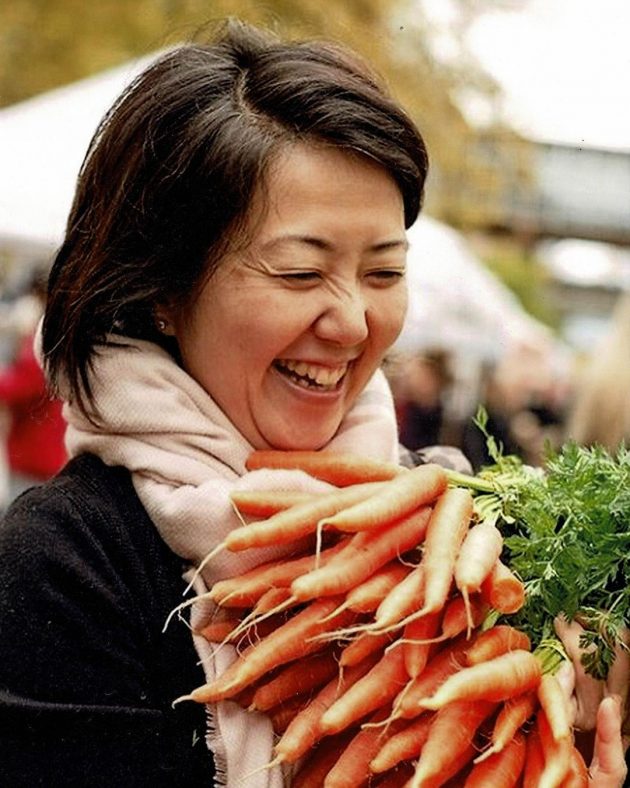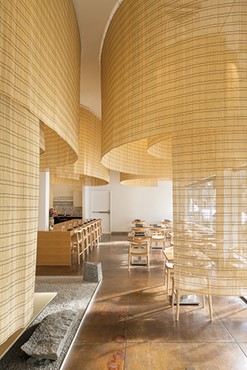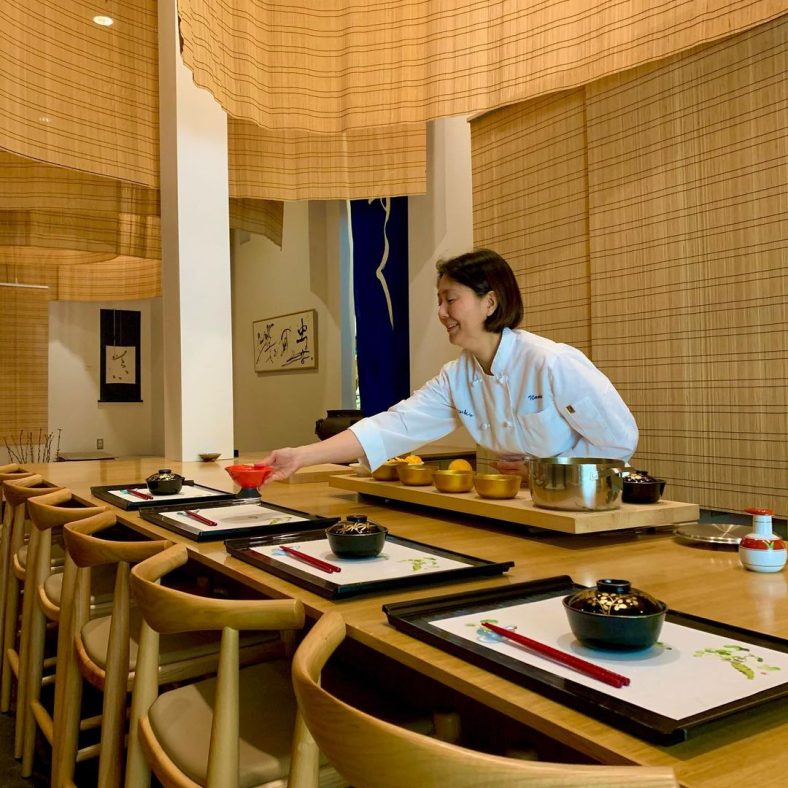MUSINGS FROM DIANE DURSTON, CURATOR EMERITA
Comfort food can make you feel at home no matter where you are. Chef Naoko’s bentos remind me of home—the home I knew for 18 years on the backstreets of Kyoto a long time ago. The fragrance of yuzu, the flavor of the finest kombu dashi broth, the crunch of homemade takuan pickles, the incomparably delicate flavor of the highest quality steamed rice. A simple bento carefully prepared and beautifully arranged can do that for you. Bring back all those memories, especially in times as bleak as they were in Portland when the virus took hold in the spring of 2020.

And yet there is nothing really simple about Chef Naoko’s bentos because every ingredient is extraordinary— organically grown vegetables and meat selected at the peak of season, sourced from local family farms. No chemicals. Nothing but healthy, flavorful goodness.
In spite of her modesty, the good-natured Naoko Tamura has been respectfully referred to as Chef Naoko in Portland for more that 12 years, and she has become something of a celebrity in town ever since Kengo Kuma designed the interior of her small downtown café “Shizuku” in 2016. Last year, Chef Naoko was named a semi-finalist for Best Chef in the prestigious James Beard Award competition, although you can still spot her any given Saturday, pulling a little red wagon through the tree-lined park on her way back to her cafe from the Saturday Farmers’ Market, loaded with fresh carrots and daikon. She brings fresh, healthy Japanese cooking to Portlanders eager to learn what real Japanese cuisine could be.
The path that led Naoko to Portland was not easy. No stranger to having the odds stacked against her, she was not even supposed to have lived this long. The story of how Naoko not only survived, but came to bring her special sense of calm and comfort to Portland and became one small shining light in a long dark winter is a story best told in her own words.
DD: Tell us about how you came to be “Chef Naoko”.
NAOKO: I was born in Tokyo in the 1970s, and one of my earliest memories is of being sick and frequently taking time off school on several occasions after I started first grade. I was born with a serious heart condition, known at that time as a “hole in the heart.” The doctors warned my mother that I might not survive, but my mother never gave up. My grandfather had always refused to buy the bleached flour imported from America, preferring the unbleached flour produced in Japan. Having learned from him of the importance of living a healthy life and eating only food untouched by chemicals, my mother moved the family out of Tokyo and into our beach house in Chiba, where the air and water were cleaner. She also became incredibly careful to select only the freshest and most nourishing foods. Within just a couple of years, thanks to my mother, my heart had actually repaired itself naturally!
DD: I understand that your mother was instrumental not only in your recovery, but in starting the natural foods movement in Tokyo.
NAOKO: She did! At first, as she nursed me back to good health, she became able to tell by slight differences in smell that some vegetables seemed more natural than others, or that meat originating from one source tasted purer than from another, noticing the subtle differences. She started to visit farms to check how they produced their food, and how they treated their animals. In her quest for a diet to support my delicate existence, my mother had begun to discover the organic food movement, which was little known in those days.
My first day of elementary school was exciting, though I quickly became aware that everyone had to conform to all school regulations: when shoes should be removed, when to clean up, etc. Treating all students the same and discouraging expressions of individualism are the hallmarks of Japanese education. This extended to school lunches with a single fixed menu for everyone.
My mother had been wary of this, but at first she was not willing to make what would have been a very unusual challenge to such established customs as the kind of foods served in the cafeteria. She also trusted my ability to detect and avoid a “chemical taste and smell” which was very obvious to me in food which contained preservatives. At first, I was okay. I avoided anything which had the suspect taste. But I remember well when those little red sausages were on the menu. They smelled strong, but tasted very good, which I suppose masked the harmful additives which made me sick the very next day.
DD: Did your mother take her concerns to school officials?
NAOKO: Yes, she met with the school principal to complain, but he was completely dismissive. His consistent response was that “Your daughter was the only child who became sick and therefore it cannot be a problem with the food.” But my mother’s interpretation was quite different. The sausages contained artificially preserved meat colored with red food dye. Her own daughter had an immediate and serious response, but she knew that others might suffer the consequences later in life without knowing the cause. She realized that I was like the canary in the coal mine.
DD: So, your mother became a health food activist!
NAOKO: She definitely wanted to investigate further when she learned that the school lunches were consistently and routinely laced with chemical additives. With this information she enlisted the support of the PTA and approached the school again. Eventually, after a long struggle, the school committed to making changes. She even opened a special kitchen in our home where she worked with a group of volunteers who soon became committed to the same cause.
DD: How much awareness of the problem with food additives existed in Japan at the time?
NAOKO: There was almost no organic food movement in Japan at the time. My recovery had been a revelation for my mother, and she believed that the organic and natural foods she had been carefully selecting for her daughter should be made available to everyone who wanted a healthier and happier lifestyle. She opened Sumire-ya, the first organic food restaurant in Tokyo in 1976 followed soon by another in Yokohama.
DD: Didn’t the macrobiotic food movement start in Japan in the 1970s?
NAOKO: Yes, Americans may well be familiar with George Ohsawa and his disciple Michio Kushi. Ohsawa had started the macrobiotic movement in the 1930s, based on the Zen vegetarian diet of Buddhist monks. The macrobiotic diet is a very strict regime that is difficult for most people to follow. My mom’s great achievement was simply to bring people’s attention to the need to eat food that is organically grown and has no chemical additives.
Her pioneering entrepreneurship as a woman became well known and as the organic food movement started to grow. She was hired as a consultant to hotels and other businesses. Together with a professor at Chiba University, she persuaded local farmers to begin growing organic produce, and in order to support their efforts, she was one of the original group of women who started the Teikei movement, known as Community Supported Agriculture (CSA) in Japan in the 1970s, even before the idea caught on in the U.S. With my mother leading the way, neighbors got together in urban communities around the country to purchase fresh food directly from farmers who agreed to farm organically.
My mother’s name is Masayo Tamura and by the mid-eighties, she had become known nationwide. Fuji TV created a serialized drama called based on my mother and her restaurant, with the part of my mother played by famous Japanese actress Yoshie Ichige.
When the Imperial Household Agency heard about my mother’s healthy cuisine, they even hired her to cater for then Empress Michiko! My mother is now 81, and she still serves as an advisor to the Culinary Institute of America at their branch campus in Singapore, where still teaches and lectures from time to time.
I learned everything from my mother and owe everything to her. She taught me that as long as you don’t give up, you will find a path to the next step on your way to a better future for the next generation.
DD: What made you decide to leave your mother’s restaurant and come to the US?
NAOKO: Our first family restaurant was called Sumire-ya, named after the wild violet (or sumire in Japanese). It was not far from our home in Ogikubo, Tokyo, and it was where I did most of my culinary training. My mother did send me off to Italy for a month to broaden my perspective, and I returned full of new ideas and dreams. My elder sister was working with my mother as the manager of Sumireya, andI gradually realized that the time was right for me to set off on my own. One of our regular customers at Sumire-ya was a man named Graham Bell who worked for Hewlett Packard in Tokyo. The first time he came in, he forgot to bring his wallet! I not only told him it was fine to come back and pay us later, but offered him train fare to get home. He must have been impressed, because he eventually he invited me to visit him in Portland where he had a home. I found so much great food available at the public farmers’ markets there. They even have a shop called Ota Tofu, which had been making excellent tofu since 1911! I visited Ayers Creek Farm just outside Portland, and I still buy my vegetables and flour from them today. I was hooked! And Graham is now my husband and business manager!
DD: When did you open your restaurant?

NAOKO: I loved Portland, but I was pretty disappointed with the handful of existing Japanese restaurants I found here when I first arrived. In 2007, I decided to open Chef Naoko’s Bento Café to help Portlanders understand what Japanese bento culture is really all about. I hired local servers to help, and ran my kitchen with emphasis on the need for maintaining a feeling of calmness in the restaurant and kitchen at all times. I posted strict rules of staff behavior all with the goal of creating a peaceful environment—”no swearing or bad language, no whistling, and no compromising on quality or service.”
“Shizuku by Chef Naoko” Restaurant by Kengo Kuma | 2017-07-01 | Architectural Record
My business gradually caught on in spite of the challenging location on a neglected side-street in downtown Portland. There were only a few tables and much of my business was take-out. I insisted on using fresh produce only in peak season purchased from a growing number of farmer friends, so my bentos were a healthy choice for lunches. Gradually I earned a following of faithful customers.
I also began catering events at places like the Portland Japanese Garden and the Japan America Society of Oregon, and from there on the café’s reputation grew and eventually I landed NIKE and LAIKA, the animated film company, as catering customers. We are even listed on the credits to the film “Kubo”!
DD: Now you even cater for Delta Air Lines, right?!
NAOKO: Representatives from Delta Air Lines came by for lunch one day and invited me to cater their First Class meals on flights to Japan. It was soon clear that I needed to expand! I needed a much bigger kitchen and a restaurant to match. I took a lease on the shopfront next door when it became available and started expanding.
Around that time, the Japanese Garden launched a project to develop an expanded cultural facility adjacent to the Garden and they were fortunate to lure the famous architect Kengo Kuma to Portland to design their new buildings. One late night meeting the Garden brought in bentos from our cafe, and Kuma-san became an instant fan. He lives much of his life on jumbo jets at 30,000 feet, and he said my healthy Japanese cooking reminded him of home. When I asked him if he knew of anyone that might help remodel my little restaurant, Kuma-san told me not to worry—he’d take care of it. And to my surprise, he did! With Kuma-san’s stunning new interior design, we renamed our expanded space Shizuku ( 雫 ), a name that was inspired by Oregon rain which helps to grow many beautiful ingredients. Keeping within my very small budget, he and his staff totally transformed our space far beyond my expectations. Sometimes the light streams through the front windows, filtered through the sudare blinds in just such a way that makes even the rainiest Portland day seem like a miracle of light and grace. We are the first and still the only restaurant in the US designed by Kengo Kuma!
ENTER THE PANDEMIC

All was well at Shizuku when the first Corona virus victim arrived in Seattle in January 2020. Business was booming! But within a few months as the COVID 19 situation worsened, restaurants were ordered to close, and it seemed that Shizuku was next. The skies darkened as unexpectedly severe wildfires raged just outside the city. Public unrest grew into open conflict in the streets protesting the killing of one too many black people, resulting in broken windows boarded up and covered with graffiti. People lost their jobs. Homelessness increased, and many small shops had to close for good.
Amazingly undaunted, Naoko rose to this latest challenge. She not only managed to keep her business going throughout the year—but she completely re-invented it. She set about developing recipes that could be prepared and frozen for take-out. Realizing people would not be familiar with how to prepare her food at home, she began making how-to videos and posting them on her own YouTube channel. (See below).
Faithful customers were thrilled to know they could order online for pick-up at curbside. Sadly, with the restaurant still closed, she had to let most of her beloved staff go. She gets by now with one young, dedicated assistant, who works in the kitchen, makes the videos, and does whatever needs to be done to help her stay on track. Her husband Graham continues to handle the marketing and business management. Despite personal and public hardships, together they maintain an upbeat and gracious presence.
“I was devastated at first,” Naoko says. “I had everything I dreamed of! And then suddenly, Delta stopped flying, the Japanese Garden closed, and I was forced to close my beautiful newly designed restaurant.”
“Life comes at us from such unexpected directions. But like my mother said, ‘If you refuse to give up, you will find a path forward.’ So, I go on trying to do what I can to keep my customers happy and my dream alive. Portland is still a beautiful place to live. So much green all around us, and so many creative people here who believe in living a healthy life.”
Portland’s streets are mostly empty for now, but because of Naoko Tamura and others like her, we all have hope. She makes sure we continue to have a way to stay healthy and happy until the pandemic subsides. From behind her mask, she maintains her positive smile and teaches us the lessons of hospitality and care that are at the heart of real bento culture.
For Portland, Chef Naoko has taken the notion of “comfort food” to a whole new level.
Visit the Shizuku website at: https://www.shizukupdx.com
Watch Chef Naoko’s cooking videos at: https://www.youtube.com/channel/UCFeDKZjazO6gcQ3cdX02Hwg